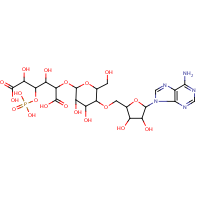Thuringiensin
Agent Name
Thuringiensin
CAS Number
23526-02-5
Formula
C22-H32-N5-O19-P
Major Category
Biological Agents

Synonyms
Bacillus thuringiensis B toxin; Bacillus thuringiensis exotoxin; Exotoxin; Thuringiensin A; Thurintox; Turingin-1 [Russian]; beta-Exotoxin (Bacillus thuringiensis); D-Allaric acid, 2-O-alpha-D-glucopyranosyl-, 4-(dihydrogen phosphate), 4'-5'-anhydride with adenosine (9CI); D-Allaric acid, O-5'-deoxyadenosin-5'-yl-(5'.fwdarw.4)-O-alpha-D-glucopyranosyl-(1.fwdarw.2)-, 4-(dihydrogen phosphate); D-Allaric acid, O-5'-deoxyadenosinyl-(5'-4)-O-3,6-anhydro-alpha-D-glucopyranosyl-(1-2)-, 4-(dihydrogenphosphate); [ChemIDplus]
Category
Bacterial Toxins
Sources/Uses
Bacillus thuringiensis strains of bacteria produce delta-endotoxins that are used to control various types of insects; Some isolates also produce thuringiensin, a beta-exotoxin that has to be removed from insecticide production batches; [Reference #1] "Bacillus thuringiensis (or Bt) is a Gram-positive, soil-dwelling bacterium, commonly used as a biological pesticide; . . . During sporulation, many Bt strains produce crystal proteins (proteinaceous inclusions), called δ-endotoxins, that have Insecticide action. This has led to their use as insecticides, and more recently to genetically modified crops using Bt genes. Many crystal-producing Bt strains, though, do not have insecticidal properties." [Wikipedia]
Comments
Causes stiffness, change in cardiac rate, and respiratory stimulation in inhalation lethal-concentration studies of rats; [RTECS]
Reference Link #1
Biomedical References
Exposure Assessment
Lethal Concentration
LC50 (rat) = 300 mg/m3
Diseases, Processes, and Activities Linked to This Agent
Other Information
No other related information on this agent was found.